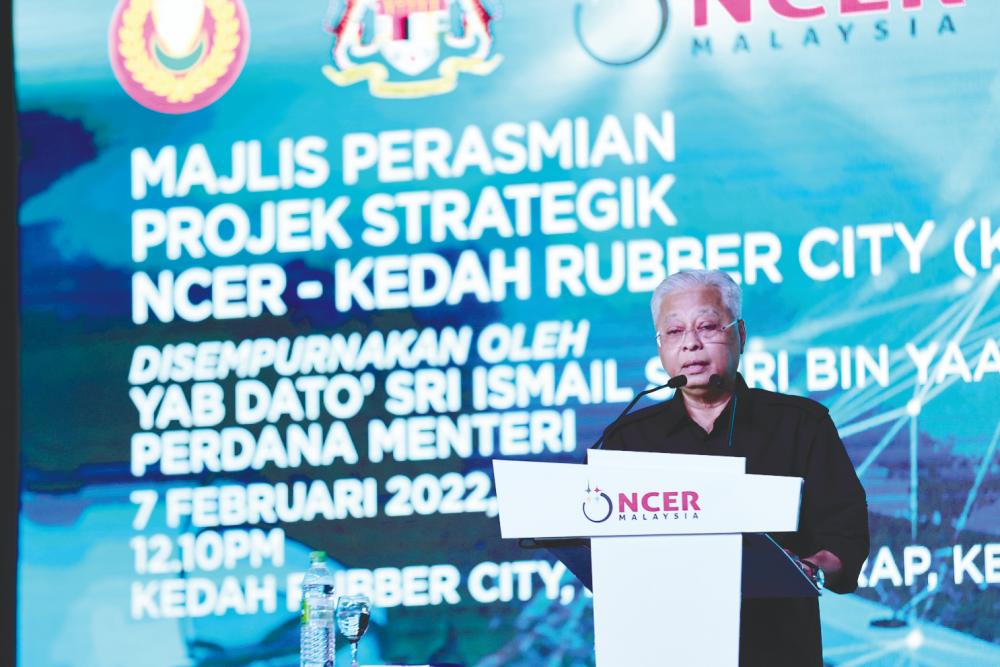PETALING JAYA: The Northern Corridor Implementation Authority’s (NCIA) anticipates the Northern Corridor Economic Region (NCER) post-pandemic economic growth trajectory to continue in 2022.
“NCER is currently facing a bright economic outlook, whereby the region is projected to achieve a robust regional GDP growth of 6.5-6.9% in 2022,” said Prime Minister Datuk Seri Ismail Sabri Yaakob (pix) in a statement.
He listed positive investor sentiment, prioritisation of catalytic projects and programmes, as well as attractive incentives by the federal government through NCIA are expected to sustain the region’s growth momentum.
“In 2021, NCIA has successfully facilitated investments amounting to RM26.27 billion into NCER compared to the original target of RM16 billion, that will create 30,573 new jobs for the rakyat,” he said.
Ismail highlighted NCER also took the lion’s share of approved manufacturing sector investments in Malaysia throughout the first three quarters of 2021 with 61.4% of total investments in the country during the period.
The period also saw a 20% year-on-year increase of the region’s export performance accounting for 36% of the country’s exports, driven by growth in the manufacturing of electrical & electronics (E&E), medical devices, and palm oil products.
Unemployment rate in NCER also remains below the national unemployment rate at 4.1% as of Q3’21, while the labour force participation rate has increased steadily to 67.8% and is expected to continue to show an uptrend in 2022.
NCIA’s recovery efforts have adopted a three-pronged approach namely facilitating private investment, implementing key strategic projects and empowering the people through human capital programmes as outlined in the NCER Strategic Development Plan (2021-2025) and Post-Covid-19 Strategic Framework.
On Monday, the prime minister also launched Kedah Rubber City (KRC), Malaysia’s first dedicated rubber eco industrial park that is expected to sustain the current growth trajectory of Kedah and NCER.
To date, the park has already attracted some RM4 billion worth of committed investment that will create 7,000 new job opportunities and it is on track to meet its RM10 billion private investment target by 2025, five years earlier than the original target of 2030.
The investment will create around 15,000 job opportunities for the locals, not only in Padang Terap but also Kedah in general.
Pioneering the investment in KRC are Hong Seng Industries Sdn Bhd, which plans to build one of the world’s largest nitrile butadiene latex (NBL) plants in the industrial park starting this year, and LTS Logistics Sdn Bhd, which will establish an integrated logistics ecosystem in KRC comprising a logistics hub, container depot and warehouse.
The project will developed in two phases spanning 1,244 acres as part of the federal government’s national strategic projects with the aim of making it a global hub for high-value rubber industry.
Phase 1 of KRC development has already been completed, while the next phase is scheduled to commence in 2023.
KRC is expected to boost the income of rubber smallholders with continuous demand for natural rubber which would stabilise rubber prices through the production of value-added downstream products.
It will also leverage on its strategic location along the “Rubber Belt” area of the Malaysia Thailand border and within the Indonesia-Malaysia-Thailand Growth Triangle and serve as a rubber product innovation centre to support downstream and upstream activities for the sector.









